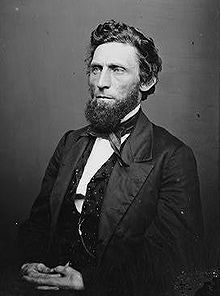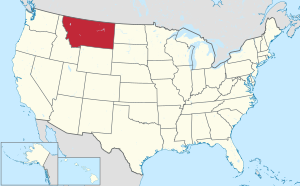|
United States of America
Montana 100 Years as Territory & 75 Year Statehood Founding
1964 Silver Medal 64mm (151.7 grams) of 0.999 Pure Silver
Heads of three important figures of Montana named EDGERTON TOOLE and BABCOCK with 1864 1964 across fields; COURAGE • VISION • PROGRESS below.
MONTANA TERRITORIAL CENTENNIAL STATEHOOD DIAMOND JUBILEE on either side of scenes from Montana with 75 above 100 above it and 1864 1964 MONTANA 1889-1964 below.
EDGE LETTERING: 140 MEDALLIC ART CO NY .999+ PURE SILVER
You are bidding on the exact item pictured, provided with a Certificate of Authenticity and Lifetime Guarantee of Authenticity.
 Sidney Edgerton (August 17, 1818 – July 19, 1900) was an American politician, lawyer, judge and teacher from Ohio. He served during the American Civil War, as a Squirrel Hunter. During this time, Edgerton served as a U.S. Congressman. In 1863, Abraham Lincoln appointed him the first Chief justice of the Idaho Territorial Court. Edgerton lobbied for the creation of separate territories, out of the Idaho Territory, and in 1864, Abraham Lincoln appointed Edgerton as the first Territorial Governor of Montana. During his term as Territorial Governor, he was an alleged member of the infamous Montana Vigilantes, and was reputedly among its founders. Sidney Edgerton (August 17, 1818 – July 19, 1900) was an American politician, lawyer, judge and teacher from Ohio. He served during the American Civil War, as a Squirrel Hunter. During this time, Edgerton served as a U.S. Congressman. In 1863, Abraham Lincoln appointed him the first Chief justice of the Idaho Territorial Court. Edgerton lobbied for the creation of separate territories, out of the Idaho Territory, and in 1864, Abraham Lincoln appointed Edgerton as the first Territorial Governor of Montana. During his term as Territorial Governor, he was an alleged member of the infamous Montana Vigilantes, and was reputedly among its founders.
He was a sickly child that was not expected to survive; burial clothing was ordered for him. He survived and, eventually, moved to Ohio. He became a lawyer, and was involved in both the Free Soil Party and the Republican Party. After John Brown’s raid on Harpers Ferry, Edgerton was invited, by Brown’s family, to settle Brown’s affairs. He never was able to meet with Brown. He had a successful career as a politician, and after his term ended in the Territory of Montana, Edgerton returned to Ohio. He served as a lawyer in his home state until his death in 1900.
 Joseph Kemp Toole (May 12, 1851 – March 11, 1929) was a Democratic politician from Montana. He served as the first and fourth Governor of Montana. Joseph Kemp Toole (May 12, 1851 – March 11, 1929) was a Democratic politician from Montana. He served as the first and fourth Governor of Montana.
Toole was born in Savannah, Missouri and attended public school in St. Joseph, Missouri. In 1868, he graduated from the Western Military Institute in New Castle, Kentucky with honors. He moved to Helena, Montana in 1870; studied law and was admitted to the bar in 1871 and commenced practice in Helena. Toole was district attorney of the third judicial district of Montana (1872-1876), and a member of the Montana Territorial House of Representatives (1879-1881), and member and president of the Montana Territorial Council (1881-1883). He married Lily Rosecrans and they had three children.
Toole was a delegate to the State Constitutional Convention at Helena in 1884 and 1889, and elected as a Democrat to the Forty-ninth and Fiftieth Congresses (March 4, 1885 – March 3, 1889); he did not seek renomination in 1888.
Toole was the first Governor of Montana (the only Democrat on the ticket that year to be elected), serving from November 8, 1889, until January 1, 1893. He resumed practice of law in Helena. Toole was a delegate to the Democratic National Conventions in 1892 and 1904.
He served as the fourth Governor of Montana from January 7, 1901 until April 1, 1908, when he resigned because of ill health. During his tenure, county treasurers were authorized to collect taxes on personal property, and there was legislation to ensure mine safety and mineworker protection.
Timothy Milford Babcock (October 27, 1919 – April 7, 2015) was an American politician, the 16th Governor of the state of Montana, from 1962 to 1969.
Babcock was born in Littlefork, Minnesota, the son of Olive (Rinehart) and Erwin Babcock. He graduated from Dawson County High School in 1939. He married Betty Lee on September 21, 1941, and they had two children. After graduating from Dawson County High School in 1939, he worked at a Douglas Aircraft factory in California. In 1944, he enlisted in the US Army as an infantryman, and served with the 394th Infantry Regiment, 99th Infantry Division in the European Theater during World War II. He fought at Elsenborn Ridge, part of the Battle of the Bulge. He later took part in the capture of the Remagen Bridge, where he was awarded a Bronze Star Medal for valor.
Babcock served three terms in the Montana Legislature prior to being elected lieutenant governor in 1960. He became governor in 1962 upon the death of Governor Donald Nutter. During his tenure, he proposed a three-percent sales tax to support the state government, and moderated the budget signed by Governor Nutter. In 1964, Babcock endorsed Barry Goldwater of Arizona for the Republican presidential nomination. Democrat Lyndon B. Johnson of Texas, however, was an easy winner that year of Montana’s then four electoral votes. He ran for re-election in 1964 against Roland Renne, the former President of Montana State College and the Democratic nominee. Following a close campaign, Babcock was narrowly re-elected over Renne. From 1964 to 1965, he a member of the National Governors’ Conference Executive Committee, and he chaired the Western Governors’ Conference from 1966 to 1967.
In 1966, he ran against incumbent United States Senator Lee Metcalf, and despite the fact that Democrats nationwide lost three Senate seats that year, Metcalf not only defeated Babcock, but increased his margin of victory from 1960.
When Babcock ran for re-election in 1968, he faced a stiff challenge in the Republican primary from Ted James, who had served with Babcock as his Lieutenant Governor since 1965. Babcock ended up defeating James, and advanced to the general election, where he faced Forrest H. Anderson, the State Attorney General, whom he lost to by a solid margin.
Following his defeat, he was appointed by then-President Richard Nixon to the National Advisory Committee on Oceans and Atmosphere. He was a delegate to the Republican National Convention eleven times and served on the National Republican Committee in 1997 and 2000.
In 1978, Babcock and his wife wrote a book: Challenges: Above & Beyond.
Babcock purchased the Hauser Mansion in Helena in 1969. Built for Governor Samuel Thomas Hauser, it is listed on the National Register of Historic Places.
On April 7, 2015, Babcock died in Helena, Montana, aged 95.
 Montana is a state in the Northwestern United States. Montana has several nicknames, although none are official, including “Big Sky Country” and “The Treasure State”, and slogans that include “Land of the Shining Mountains” and more recently “The Last Best Place”. Montana is a state in the Northwestern United States. Montana has several nicknames, although none are official, including “Big Sky Country” and “The Treasure State”, and slogans that include “Land of the Shining Mountains” and more recently “The Last Best Place”.
Montana is the fourth-largest in area, the 8th least populous, and the third-least densely populated of the 50 U.S. states. The western half of Montana contains numerous mountain ranges. Smaller island ranges are found throughout the state. In all, 77 named ranges are part of the Rocky Mountains. The eastern half of Montana is characterized by western prairie terrain and badlands. Montana is bordered by Idaho to the west, Wyoming to the south, North Dakota and South Dakota to the east, and the Canadian provinces of British Columbia, Alberta, and Saskatchewan to the north.
 The economy is primarily based on agriculture, including ranching and cereal grain farming. Other significant economic resources include oil, gas, coal, hard rock mining, and lumber. The health care, service, and government sectors also are significant to the state’s economy. The economy is primarily based on agriculture, including ranching and cereal grain farming. Other significant economic resources include oil, gas, coal, hard rock mining, and lumber. The health care, service, and government sectors also are significant to the state’s economy.
The state’s fastest-growing sector is tourism. Nearly 13 million tourists annually visit Glacier National Park, Yellowstone National Park, Beartooth Highway, Flathead Lake, Big Sky Resort, and other attractions.
|





 Sidney Edgerton (August 17, 1818 – July 19, 1900) was an American politician, lawyer, judge and teacher from Ohio. He served during the American Civil War, as a Squirrel Hunter. During this time, Edgerton served as a U.S. Congressman. In 1863, Abraham Lincoln appointed him the first Chief justice of the Idaho Territorial Court. Edgerton lobbied for the creation of separate territories, out of the Idaho Territory, and in 1864, Abraham Lincoln appointed Edgerton as the first Territorial Governor of Montana. During his term as Territorial Governor, he was an alleged member of the infamous Montana Vigilantes, and was reputedly among its founders.
Sidney Edgerton (August 17, 1818 – July 19, 1900) was an American politician, lawyer, judge and teacher from Ohio. He served during the American Civil War, as a Squirrel Hunter. During this time, Edgerton served as a U.S. Congressman. In 1863, Abraham Lincoln appointed him the first Chief justice of the Idaho Territorial Court. Edgerton lobbied for the creation of separate territories, out of the Idaho Territory, and in 1864, Abraham Lincoln appointed Edgerton as the first Territorial Governor of Montana. During his term as Territorial Governor, he was an alleged member of the infamous Montana Vigilantes, and was reputedly among its founders.  Joseph Kemp Toole (May 12, 1851 – March 11, 1929) was a Democratic politician from Montana. He served as the first and fourth Governor of Montana.
Joseph Kemp Toole (May 12, 1851 – March 11, 1929) was a Democratic politician from Montana. He served as the first and fourth Governor of Montana.  Montana is a state in the Northwestern United States. Montana has several nicknames, although none are official, including “Big Sky Country” and “The Treasure State”, and slogans that include “Land of the Shining Mountains” and more recently “The Last Best Place”.
Montana is a state in the Northwestern United States. Montana has several nicknames, although none are official, including “Big Sky Country” and “The Treasure State”, and slogans that include “Land of the Shining Mountains” and more recently “The Last Best Place”.  The economy is primarily based on agriculture, including ranching and cereal grain farming. Other significant economic resources include oil, gas, coal, hard rock mining, and lumber. The health care, service, and government sectors also are significant to the state’s economy.
The economy is primarily based on agriculture, including ranching and cereal grain farming. Other significant economic resources include oil, gas, coal, hard rock mining, and lumber. The health care, service, and government sectors also are significant to the state’s economy. 




